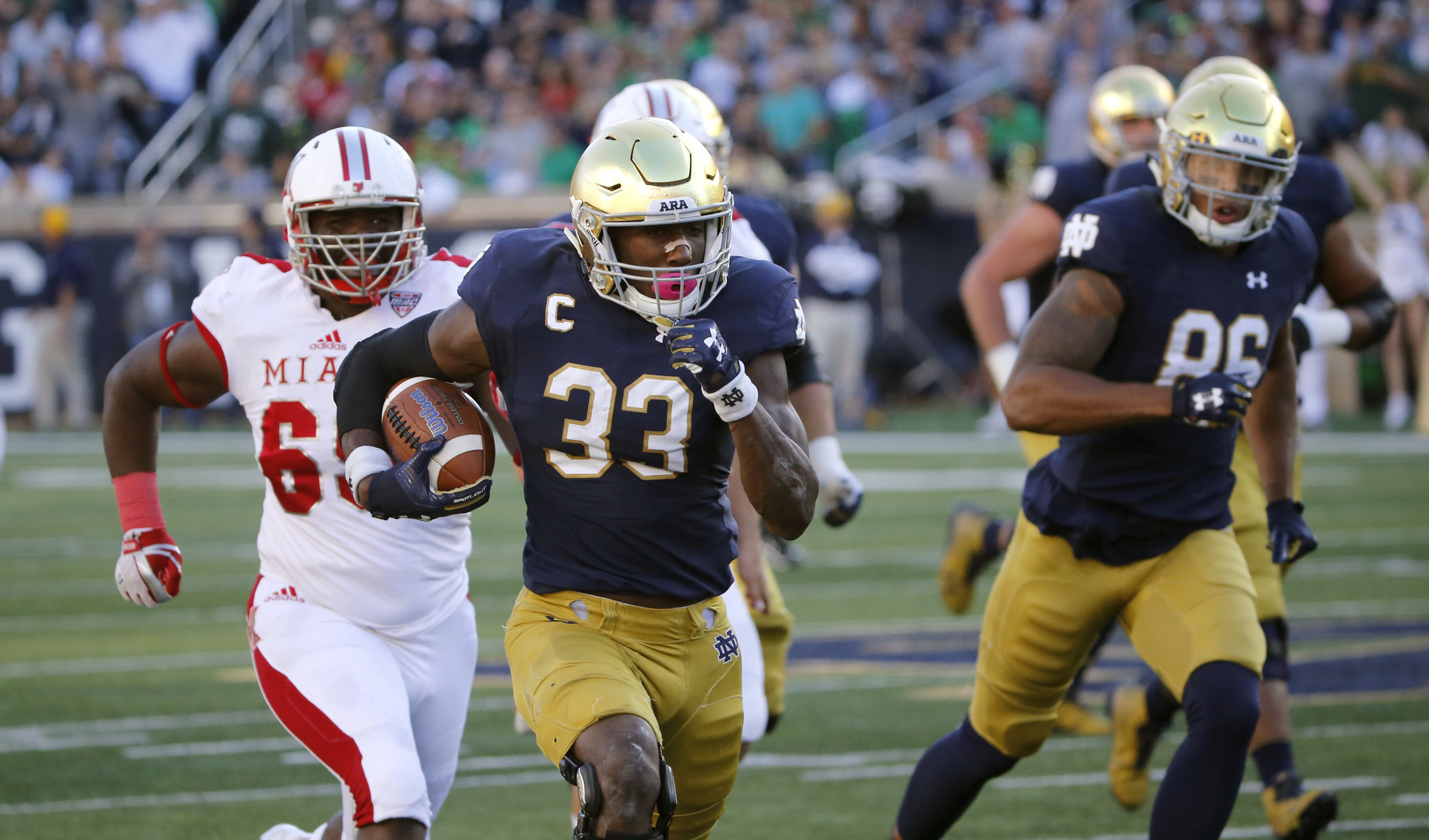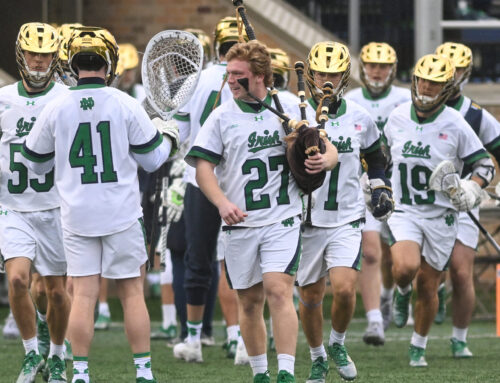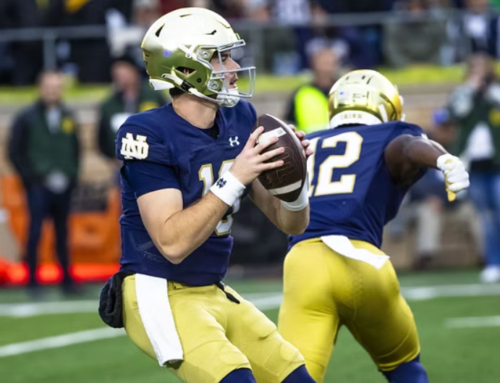Reviewing Notre Dame’s cruise-control victory against the closer Miami: it’s nice to have an offense whose floor includes often putting up nearly 50 points and rushing for 300 yards, and why there’s a few reasons for caution before getting too optimistic about this Irish defense.
The basics

In a game that was never in doubt for the Irish, once again garbage time played a major role in the final box score. The game crept into that territory as early as the second quarter, but officially started at halftime, so a weighty 47% of plays took place in garbage time. The Irish scored on seven of their first eight possessions before transitioning into the 2nd Grade Free Time offense*.
*In 2nd grade during free time, our teacher would let us either read books or practice typing on a Macintosh PC. I’m not sure how to work in a Montgomery Van Gorder reference, but thank you for hopefully not closing the tab at my bad jokes.
Explosiveness

I really hoped after Michigan State we turned the page and would look back at debates about Brandon Wimbush’s passing ability the same way we now think about questioning Mike Brey’s ability to win postseason games. Unfortunately, it is again leading off the Notre Dame-centric version of PTI this week, even after you know, rushing for 300 yards again and averaging almost ten yards per play before garbage time. The bright side is that the passes Wimbush connected on went a long way, including a 54-yards bomb to Miles Boykin before halftime. The Irish are now up to 33rd nationally in passing IsoPPP (explosiveness), which a function of both of not being successful on many passes but being very successful when they land those shots.
It’s also encouraging that the floor for the offense even when Wimbush is not passing well is still this high. In his three worst games so far (UGA, BC, Miami) where the junior less than 50% of his passes, the offense has still rushed for 301 yards and averaged 40 points per game. The concerns are real and valid, because Georgia stands as the perfect case study of what can happen if the run game bogs down against better teams on the schedule. But I also think an explosive but inefficient passing game is still probably good enough to get this team past almost every team remaining on the schedule, and the Irish were only a big pass or two away from beating a Bulldog team that is rapidly climbing the rankings.
Efficiency

On the defensive side of the ball, the Mike Elko honeymoon period continues, and Brian Kelly starts wondering if maybe he’s finally found the one. Forcing two first quarter turnovers enabled the nearly perfect red zone offense to score twice on short fields, and the defense held the Redhawks to a 20% success rate in the first quarter.
The one area of slight disappointment was in the second quarter. While Brian Kelly challenged the team to focus on mental toughness in this game and considered the performance a success, I think there’s some signs of letting up a bit after coasting to an early lead. After the Irish went up 35-7 with 42 minutes of game time remaining, the defense gave up successful plays on 8 of next last 11 snaps. This boosted the Redhawks to a way-too-healthy 6.19 yards per play before garbage time, which is not great against an over-matched opponent.

Zooming out for a minute to look at the big picture, it’s interesting to see how through five games Elko’s defense has transformed from 2016 and found such immediate success. The peripherals all look good – the Irish are 12th in opponent efficiency, 13th in limiting opponent scoring drives, and top 15 in turnovers forced. Explosiveness has been excellent as well, with just two plays allowed over 40 yards (tied for 12th nationally).
All of these are excellent numbers, especially limiting efficiency, which should be more sustainable in the long run than turnovers (where the Irish have been a little lucky, statistically) and limiting scoring opportunities. But opponent-adjusted stats are still largely unavailable this early in the season, and it hasn’t been a murderer’s row of opposing offenses in Temple (120th in Offensive S&P+), Georgia (42nd), Boston College (124th), Michigan State (76th), and Miami OH (104th). In fact, when you look at numbers with garbage time filtered out, the Irish have allowed more YPP to most opponents than an average team.

There are a number of ways you could explain this away – some of these games weren’t really competitive even before the garbage time criteria was met, for example – but I think it limits my excitement about the defense just a bit. You could debate where Georgia should fit in, but by current S&P+ rankings the five best offenses the Irish will face in 2017 are coming in the second half of the schedule with USC (15th), NC State (29th), Miami FL (16th), Navy (26th), and Stanford (26th).
Elko has a track record of doing this type of thing before – he fielded excellent defenses not allowing opponents to finish drives at Wake Forest in 2016 (#18 in FBS) and 2014 (#19). He’s fielded effective bend but don’t break defenses before too, and that’s been a winning formula playing to the strengths of this Notre Dame defense. The Irish have been due for a turnaround in turnover luck for a long time.
But I think there’s some underlying warning signs that the defense may take a step back later this year – one that won’t hurt too much if they can keep up the turnovers and shutting down the red zone, but may be trouble if either slips. I should be happy with the progress from the defense and not worry about things that I haven’t seen yet, but then what kind of Notre Dame fan would I be? Ideally, a struggling UNC team is a good proving ground to hold another opponent below their average YPP, and then we’ll see all of Elko’s cards fully on the table against USC after the bye.
Finishing Drives, Field Position, & Turnovers

The Irish continue to hum along in the red zone on offense and tighten up when the field gets shorter for opponents. In addition to having more scoring opportunities than opponents, the combined advantage of excellence on both sides of the ball in scoring opportunities has created a huge advantage. Notre Dame is now averaging 5.56 points per trip inside the opponent 40, while foes have scored just 3.25 points per trip. Converting touchdowns and forcing opponents to settle for field goals has allowed ND to lock up games earlier, which means valuable time for young guys and to put your quarterback through a live passing drill, and all of that will hopefully have a valuable trickle-down effect as the season progresses.
Thanks to the two early turnovers, Notre Dame enjoyed a huge field position advantage before garbage time. The Irish started their average drive at their own 38 while Miami’s average start was their own 27. Special teams were mostly blah as the game quickly got out of hand – it wasn’t Tyler Newsome’s best day (but we also got to see a punt from a Jeff Riney!). Justin Yoon has missed his three field goals by about as few combined inches as possible, and maybe we will just have to settle for subpar kickoffs and coverage all year.
On to North Carolina
The Tar Heels were projected 37th in preseason S&P+ and 44th in FEI, and have already fallen 61st in S&P+ with a 1-4 start. This always figured to be a rebuilding year for Larry Fedora and his offense-first approach – in addition to losing Mitch Trubisky, Carolina lost their top two rushers, three starters on the offensive line, and just one of the six receivers that received 20 targets last season. That one receiver, senior Austin Proehl, is now out for the year. The Heels were already 128th out of 129 FBS teams in terms of returning offensive production, and that was before the injury bug went full West Nile virus in Chapel Hill.
After quickly learning that Brandon Harris was bad and it wasn’t just an LSU quarterback curse, Fedora turned the keys over to redshirt freshman Chazz Surratt. Thrust into a tough situation he performed admirably in a loss to Louisville and rout of Old Dominion, but struggled tremendously last week at Georgia Tech (141 yards on 4.7 YPA). The offensive line and run game haven’t helped – UNC is just 75th in Rushing Efficiency and 92nd in Passing Down Sack Rate. Fedora may eventually figure something out, but right now the combination of a shaky new QB, inexperienced line, zero proven receiving threats, and an inefficient running game has been too much to overcome.
Defensively things aren’t pretty either. North Carolina has allowed opponents to either by extremely efficient (Georgia Tech), explosive (Cal and Duke), or both (Louisville). And while opponent adjustments will help, UNC is currently 101st in opponent efficiency and 102nd in opponent explosiveness. They simply have not been able to get off the field, allowing opponents success on 40.2% of passing downs (national average is 30.6%) and rankings 96th in opponent third down conversions.
So while Notre Dame’s schedule now features some teams that are currently overachieving relative to preseason predictions like Wake Forest and Miami, they may have caught UNC at the right time. Here’s three key stats to watch on Saturday:
Notre Dame Passing Efficiency
I have no doubt the Irish will be able to generate explosive plays against the beleaguered UNC defense, so this is really a question of what type of Brandon Wimbush performance we’ll see. So far, the passing game has posted one efficient game (Michigan State), one average game (Temple), and three inefficient games (UGA, BC, and Miami). Carolina has allowed 8.0 yards per attempt so far this season – can Wimbush top the 7 YPA mark for the second time this season? The North Carolina defense doesn’t have a scary pass rush, so it’s another test to see if Wimbush can stay comfortable in the pocket, find open receivers, and deliver the ball with accuracy.
Note: Now this could also be intriguing because of the possibility of a very early Book club meeting in Chapel Hill. Stay tuned.
North Carolina Passing Explosiveness
The Tar Heels haven’t had a very explosive passing offense, but you can bet they paid attention to James Gardner’s performance against Nick Watkins and the Irish secondary on film. While the North Carolina receiving corps has experienced a ton of turnover and isn’t the biggest, it wouldn’t surprise to see Fedora try a lot of jump ball along the sidelines and deep on Saturday. As a big underdog, I think he’ll challenge Notre Dame deep, and these should be low-risk, high-reward throws that could result in explosive passes or drive-extending penalties. Keep an eye on how the Watkins and Elko respond, especially while the game is up for grabs.
Notre Dame YPP Allowed
Building off the earlier discussion on defensive improvement, the next step to continue improving is smothering opponents, relying less on turnovers and stopping opponents on scoring opportunities. This is probably getting greedy – why are we asking more out of a defense that’s top 20 in Defensive S&P+ and top-25 in opponent points per game? The answer is that while the offense remains a little bit of a work in progress, the defense is going to have to be as good if not better to beat the top teams on the second half of the schedule.
Eventually the turnover well may run dry and an opponent will convert more scoring opportunities, and then it’s going to be necessary for the defense to elevate their every-down level of play against offenses like USC, Stanford, and Miami. Holding UNC under 5.0 yards per play (or ideally even less!) at home would be a strong step in that direction.





“In 2nd grade during free time, our teacher would let us either read books or practice typing on a Macintosh PC.”
And in 2nd Grade Free Time Offense, our coach lets Book read defenses and McIntosh practice.
We played Oregon (Duck) trail. Willie Taggart died of dysentery.
Dysentery is 1800s rhabdo
Where can I find and FEI and S+P rankings? It would be interesting to compare the strength of schedule so far with those of previous years to see whether it is genuinely weaker or we are just taking care of business better. An article about this would be great!
FEI ratings are at bcftoys.com (usually not updated until around Week 7 or 8). S&P+ ratings are at Football Outsiders (http://www.footballoutsiders.com/stats/ncaa).
I’ll take a look at schedule comparisons versus previous years – the one caution with that and any advanced stat rankings this year is that they are still a combination of preseason projections (based on previous performance, recruiting rankings, returning production) and this year’s stats. As each week passes the preseason gets phased out more and more and this year’s stats eventually become 100%, but that’s usually not until about 7-8 weeks into the season. The impact there is that if a team we thought would be good is actually bad they drop more slowly than they would otherwise and vice versa, but it generally is a good guide to prevent overreaction to super small sample sizes early and since opponent adjustments are really difficult until you better know who is actually good or not.
And FWIW, Sagarin ratings have Notre Dame with the 30th toughest schedule thus far, believe it or not. This is bolstered by UGA (6th in Sagarin) and MSU (27th) and tells you that while this is a weaker early schedule than usual for Notre Dame, other teams are typically scheduling a lot of easy games this time of year as well.
https://www.usatoday.com/sports/ncaaf/sagarin/
Never underestimate just how easy everyone’s schedule is.
That seems legit…FEI has NDs schedule as 31st.
NC State keeps looking legit-er and legit-er
But but but every team is great until ND beats them and then we know they suck! Isn’t that how it works?!? That’s what the SECMedia tells me.
I’m not worried about a very early Book club meeting, but I am worried about mandatory Book reports.
What is the situation with Wimbush’s foot?
Believe he didn’t practice yesterday and might today. There should be an update post-practice tomorrow (Thursday). BK confirmed he was in a walking boot but that it was being extremely cautious more than anything.
He did some throwing and stationary bike work yesterday, per Kelly, and should be a full participant today. Kelly said he was “cleared to run” for today.
Hands down, my favorite Springsteen tune
Hands down but thumbs up.
Can’t wait for the Friday Night Lights: The Musical! and then Friday Night Lights: The Musical! (Movie) so it will have been a movie about a play about a tv show about a movie about a book about a real thing.
EDIT: Probably need to then include an Original Cast Recording in there, so it would be CD>Movie>Play>TV Show>Movie>Book>Real Life.
Truly, you have a dizzying intellect.
Kind of along these lines, from the cancelled far too early sitcom Happy Endings:
“You know what I was thinking about? If Mary Tyler Moore married and then divorced Steven Tyler, then married and divorced Michael Moore, then got into a three-way lesbian marriage with Demi Moore and Mandy Moore, would she go by the name Mary Tyler Moore Tyler Moore Moore Moore? Hm.”
Why is he always dissin my girl?
Moore, Moore, Moore, how do you like it?
@Russell i wonder how many of us are old enough to get that reference!
What if there was a Sioux sous chef named Sue?
“Wait ’til I get going! Now, where was I?”
Ah, beaten to the punchline.
Wait till I get going! Now, where was I?
